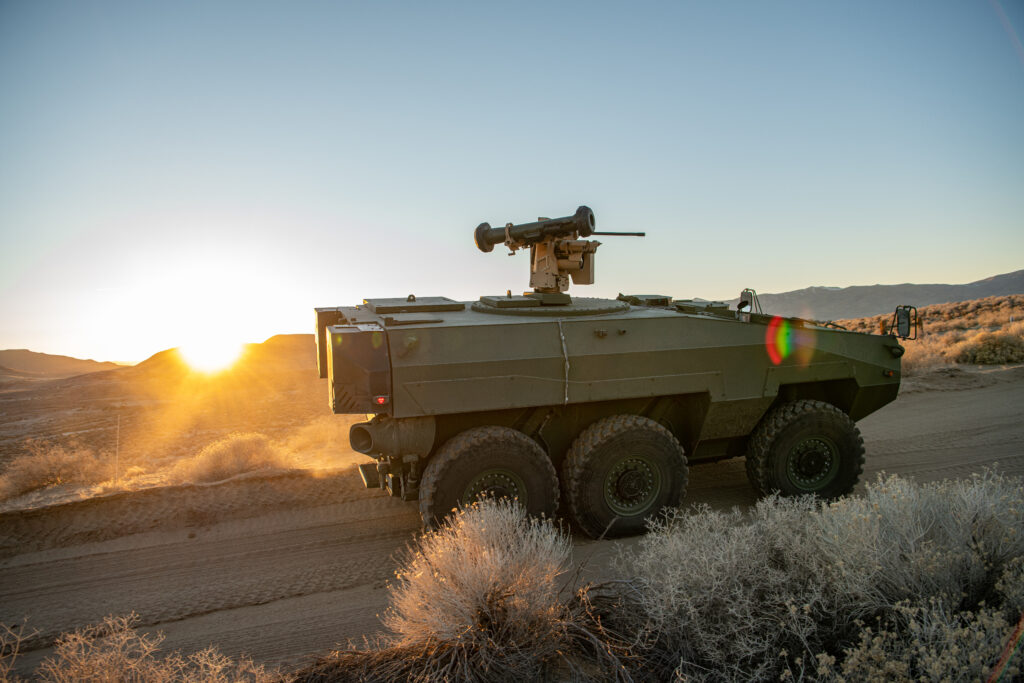
Textron Systems submitted its “Cottonmouth” vehicle for consideration to become the Marine Corps’ new ARV. (Courtesy of Textron.)
Updated at 3:20 p.m. July 19 to reflect comments from Marine Corps Systems Command.
WASHINGTON: The Marine Corps has selected General Dynamics Land Systems and Textron Systems to develop prototypes for its next-generation ground vehicle.
The Advanced Reconnaissance Vehicle (ARV) is a fifth-generation “purpose-built combat vehicle” the Marine Corps is developing to replace the aging Light Armored Vehicle fleet. It is envisioned as capable of moving on land and in water, kitted out with the latest in command-and-control capabilities to allow it to function as a hub from which Marines can use other robotic and autonomous systems.
Pending negotiations with the companies, Army Contracting Command – Detroit Arsenal will award prototyping contracts using the Ground Vehicle Systems OTA in conjunction with the Advanced Mobility Consortium, according to a Friday service statement. The contracts will likely come later this fall and be valued at around $10.5 million each, according to fiscal year 2022 Navy budget justification documents.
With unmanned systems and autonomous robotics taking a greater portion of the Navy’s budget each year, ARV is certain to carve out an important role in the Marine Corps’ force structure and strategy.
As the service begins ramping up its ARV research and development budget, requested at $48 million this fiscal year, the program is sure to solicit lawmakers’ attention. And the Marines will need to prepare for questions about the balance between being exquisite and practical.
The Corps learned its lesson the hard way, with another program known as MUX, which involves a next-generation unmanned aircraft with a bevy of missions and requirements. The service has taken criticism in recent years from both lawmakers and industry for seeking too much out of a single aircraft.
So it may not be a surprise that the Marines are also keeping an eye out for off-the-shelf options.
“In parallel to competitive prototyping, the Marine Corps is also pursuing an effort to define the trade space of a government off-the-shelf solution using the Amphibious Combat Vehicle. The data from the ARV competitive prototyping efforts and the ACV study will jointly inform a Marine Corps decision point in fiscal year 2023,” according to a Marine Corps statement.
The choice to only pursue two industry vendors is notable and somewhat unexpected. The Navy’s budget documents state the Marine Corps had originally intended to negotiate prototyping deals with three vendors. A spokeswoman for Marine Corps Systems Command told Breaking Defense on Monday the service only received “two proposals that were technically acceptable.”
The lack of a third contract could be a big loss for any of the companies in the mix to compete. According to a service solicitation published last year, the follow-on production funding for the ARV program could range from $1.8 billion to $6.2 billion over five years.
GDLS produces the service’s legacy LAV-25.
“Our collaborative industry team is focused on early integration of transformative technologies — advanced next generation electronic architecture, AI, autonomy and robotics — required to deliver this capability,” Don Kotchman, an executive at General Dynamics Land Systems, said of the service’s July 16 announcement.
Textron Systems in May unveiled the “Cottonmouth” vehicle which it said would be put forward for the ARV program.
“We listened to the customer and have invested in developing and producing Cottonmouth as a purpose-built vehicle to give the U.S. Marine Corps the amphibious mobility they need for quarterbacking the future fight,” David Phillips, an executive at Textron Systems, said at the time.
‘Poisoned’ data could wreck AIs in wartime, warns Army software acquisition chief
“Any commercial LLM that is out there, that is learning from the internet, is poisoned today,” Jennifer Swanson said, “but our main concern [is] those algorithms that are going to be informing battlefield decisions.”


























